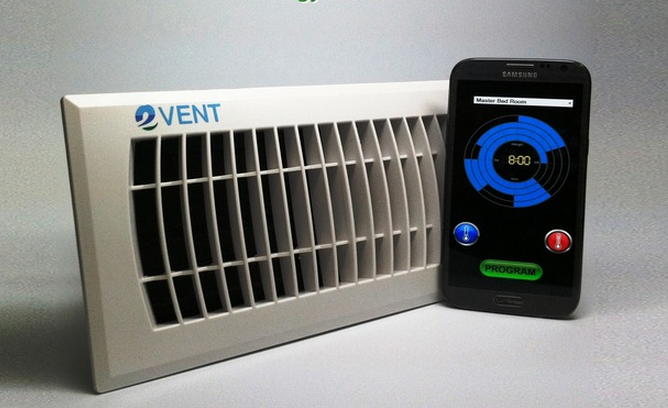
But networked thermostats like Nest or Honeywell’s new Lyric are only one part of the equation. They can do awesome energy-saving stuff like turn your heat on or off automatically and learn your preferences over time, but regardless of how sophisticated they get, these devices still can’t tell your HVAC system to specifically ignore the spaces you don’t physically inhabit. So in other words, they still heat rooms you don’t need them to.
That’s where E-Vents come in.
Developed by Utah-based startup Circle Design Technology, E-Vents are smart, wirelessly-networked vent covers that can be opened or closed remotely via smartphone. The idea is that once you’ve got them installed in place of your old vent covers, they’ll automatically redirect heating/cooling to the only the rooms that you tell it to. Based on what’s shown in the company’s Kickstarter video, it doesn’t look like the vents actually communicate with your HVAC system directly, so technically speaking they probably won’t change the amount of energy it takes to run the compressor or fan. Instead, the vents merely help to direct airflow to the parts of your house that you want, thereby reducing the time it takes to bring them to the proper temp.
Frankly, an invention like this is long overdue. HVAC vent covers haven’t gotten a significant redesign since they were first introduced to consumers, and we’re glad to see they’re finally getting a 21st-century update.
The vent’s creators are currently seeking $50,000 to manufacture the first batch, and have turned to Kickstarter to raise the money. If you back the project now, you can lock down a pair of vents for just $43, or spring for a set of six for $120. When you consider how much these things could save you on your heating/cooling bill, those prices don’t sound half bad.
Editors' Recommendations
- How to connect Alexa to your TV for smart voice control
- Do smart plugs really help to cut down energy use?
- Fluid One gives you point-and-click control of your smart home, from your smartphone
- OxeFit XS1 tracks your workout form and suggests real-time improvements
- How to control Alexa from your Windows 10 PC




